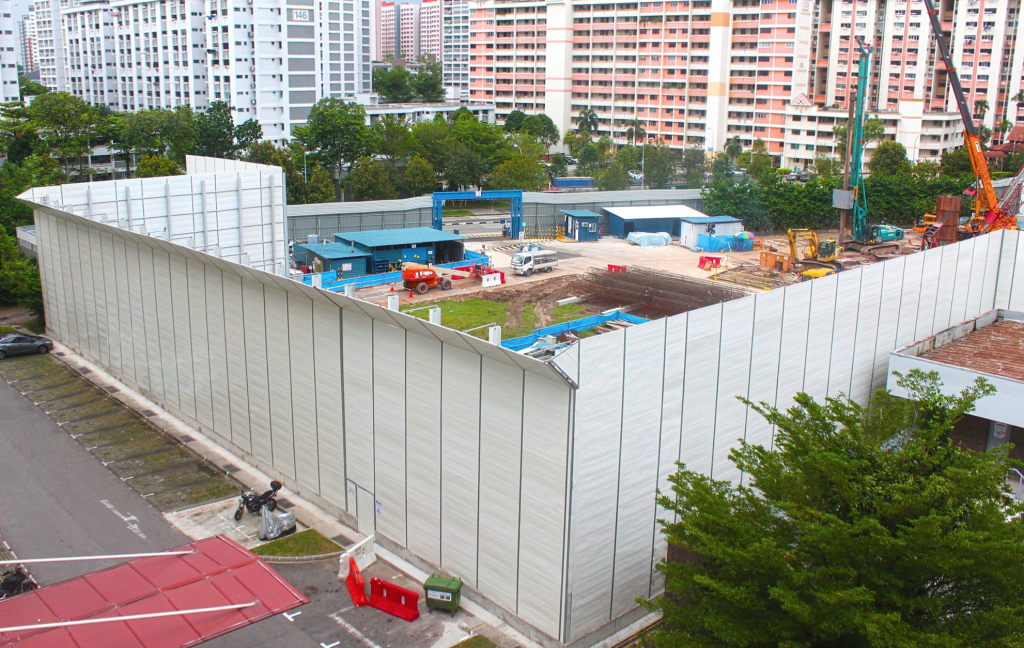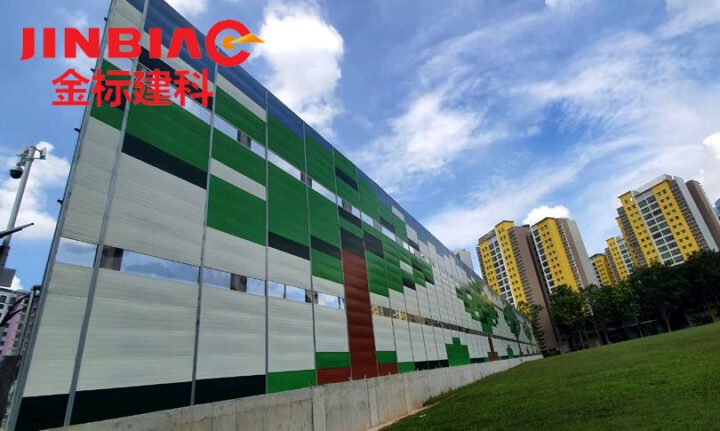
In the bustling world of sound barrier, heavy machinery hums, power tools roar, and materials crash creating a cacophony that can disturb the peace of nearby neighbourhoods and workers. The importance of sound management on construction sites cannot be overstated. It’s pivotal for maintaining good community relations, complying with noise regulations, and ensuring worker safety. But how do you effectively steer clear of sound pollution without emptying your budget?
Handling noise isn’t just about being neighbourly, but it’s about smart construction. An environment with reduced noise has higher productivity and happier crew members. The right sound control saves on complaints and potential regulatory complications, contributing to overall project success.
We’ve compiled a concise yet comprehensive list of ten cost-effective construction sound barrier solutions that can be a saving grace for construction projects.
Soundproof Drywall
Soundproof drywall, otherwise known as acoustic drywall or quiet rock, is a popular choice due to its affordability and effectiveness. It is made up of multiple layers of gypsum board, laminated with sound-dampening materials such as viscoelastic polymers or metal plates.
This combination results in a thicker, heavier, and more robust version of traditional drywall, significantly reducing sound transmission. It’s an easy and inexpensive option for indoor construction projects, as it can be easily installed like regular valuable drywall.
- Pros: This everyday building material is a champ at blocking mid to high-range sound frequencies and boasts ease of installation.
- Cons: Despite its effectiveness, soundproof drywall can cost a bit more than conventional sheetrock and falls short in combating low-frequency noise.
Acoustic Foam Panels
Acoustic foam panels, also known as sound-absorbing panels, are commonly used in recording studios and music venues to reduce reverberation and echoes. However, they can also be valuable for construction sites looking to control noise levels. These lightweight panels are made of open-cell foam with a porous structure that traps sound waves and reduces their energy. They can be easily attached to walls, ceilings, and floors with adhesive or nails.
- Pros: These spongy panels efficiently absorb sound waves and come in various shapes and sizes, offering flexibility in arrangement.
- Cons: While good for mid-range frequencies, they may not provide complete noise isolation and require regular upkeep.
Acoustic Curtains
Acoustic curtains, also known as sound blankets or acoustic drapes, are a tried and tested solution for controlling noise on construction sites. These thick, dense curtains are made of multiple layers of materials designed to absorb and block sound waves. The heavy-duty vinyl exterior acts as a barrier while the inner layers work to absorb sound energy. They can be easily hung on fences, scaffolding or installed on frames, making them an excellent temporary sound barrier solution.
Rubber Sound Barrier Mats
Rubber sound barrier mats are recycled rubber and are commonly used as flooring underlayment. However, they can also be an effective solution for reducing noise on construction sites. These mats work by isolating sound vibrations through their dense and flexible material. They come in various thicknesses and can be easily laid down on the ground or attached to walls or ceilings with adhesive.
- Pros: Portable, flexible acoustic curtains are pocket-friendly short-term project options.
- Cons: They’re less effective at noise reduction and aren’t designed for the rigours of outdoor use.
Mass Loaded Vinyl
Mass-loaded vinyl (MLV) is a heavy-duty sound barrier used in various industries, including construction. This dense and flexible material can be easily attached to walls, ceilings, and floors to block and absorb sound waves. Its effectiveness lies in its weight, which effectively reduces noise and vibration. It’s also waterproof and weather-resistant, making it suitable for outdoor use.
Construction Sound Barriers
Construction sound barrier, also known as temporary noise control barrier, or sound walls, is an easy and cost-effective solution for reducing noise on construction sites. These portable barriers are made of materials such as fibreglass, foam, or mineral wool and can be easily attached to fencing or scaffolding. They’re highly effective at blocking high-frequency sounds but may not provide complete noise isolation.
- Pros: Tailor-made for construction sites, these heavy-duty barriers are top-notch at their job.
- Cons: The specialized design comes with a cost, and setting it up may require trained personnel.
Sound Barrier Fencing
Sound barrier fencing, or noise barrier walls or acoustic barriers, is a solid structure designed to reduce noise pollution. They’re commonly used in construction sites near residential areas to protect the community from excessive noise. These walls can be made of various materials such as wood, concrete, or metal and are typically placed along the perimeter of a site to create a barrier between the construction activities and nearby properties.
- Pros: Sound barrier fencing can significantly reduce noise levels for nearby residents and workers, making it an essential solution for construction sites in residential areas.
- Cons: They can be costly to install and may require planning permission or permits from local authorities.
Recycled Rubber Mats
Recycled rubber mats are an eco-friendly option for reducing noise on construction sites. Made from recycled tires, these mats offer soundproofing capabilities while also providing a durable and slip-resistant surface. They can be easily laid down on the ground or attached to walls or ceilings with adhesive. These mats are weather-resistant and suitable for outdoor use, making them a reliable solution for noise control on construction sites.
- Pros: These eco-friendly mats dampen impact noise and can be a green alternative in construction.
- Cons: Their effectiveness with airborne noise is limited, and they may not be the longest-lasting solution.
Insulated Concrete Forms (ICFs)
Insulated Concrete Forms, or ICFs, are popular for energy-efficient and soundproof construction. These forms consist of two insulated sheets of foam with concrete poured between them. The result is a solid and durable wall that provides superior insulation and noise reduction capabilities. Building with ICFs can significantly reduce the need for additional soundproofing materials, making it a cost-effective and time-saving solution for controlling noise on construction sites.
- Pros: Offering both thermal and acoustic advantages, ICF walls mean double the protection for your project.
- Cons: Their cost and necessity for installers with specialized expertise are things to consider.
Green Roofs
Green roofs, also known as living roofs or eco-roofs, are a sustainable solution for controlling noise pollution on construction sites. These roofs are covered in vegetation, which acts as a natural sound barrier by absorbing and reflecting sound waves. They can be installed on top of traditional roof materials and offer numerous environmental benefits, such as reducing energy consumption and improving air quality. Green roofs are also aesthetically pleasing and can add value to a construction project.
- Pros: Green roofs provide both noise reduction and environmental benefits, making them a desirable solution for construction sites.
- Cons: They can be costly to install and require regular maintenance. Additionally, not all structures are suitable for green roof installation.
Sound Absorbing Paint
Sound-absorbing paint is a relatively new solution for controlling noise on construction sites. This specialized paint contains sound-absorbing materials that can help reduce noise levels by up to 30%. It’s easy to apply and can be used on a variety of surfaces, such as walls, ceilings, and floors. Sound-absorbing paint is also environmentally friendly and can be an excellent solution for reducing noise pollution in indoor spaces.
- Pros: They muffle sound and bring nature closer, improving air quality and aesthetics.
- Cons: Green roofs come with a higher price tag and require careful structural planning.
Noise-Cancelling Headphones
While not a physical sound barrier, noise-canceling headphones can effectively reduce noise on construction sites. These headphones use technology to cancel out external noises, making them perfect for workers who need to concentrate in loud environments. They’re portable and can easily be worn by workers, allowing them to focus on their tasks without being distracted by excessive noise pollution.
- Pros: Personal noise reduction that travels with you, offering a portable solution for individual workers.
- Cons: They’re not a permanent fix, and it’s not the most practical approach for everyone across a large construction site.
Natural Barriers (Trees, Fences)
In addition to man-made solutions, natural barriers such as trees and fences can also help reduce noise on construction sites. Trees act as natural sound absorbers, while solid fences can block and deflect sound waves. Planting a row of trees or building a fence along the perimeter of a site can significantly reduce noise levels for nearby properties. These natural barriers are also aesthetically pleasing and can add to the overall visual appeal of a construction project.
- Pros: Aesthetically pleasing and environmentally sound, natural barriers can slowly grow into effective sound blockers.
- Cons: The process is not overnight, and the upfront effort and cost can be significant.
As we can see, there are various solutions available for controlling noise pollution on construction sites. Each option has its pros and cons, and the best solution will depend on the specific needs of the project. However, proper planning and consideration should be given to noise control measures to ensure the well-being of both workers and nearby communities. With the right approach, construction sites can minimise noise pollution and create a more harmonious environment for everyone involved.
Conclusion
Sound barriers aren’t one-size-fits-all. The perfect solution for one construction site might be entirely impractical for another. By understanding the unique features and costs of each sound barrier, you can make an informed decision that harmonises noise and cost-effectiveness to orchestrate a successful project. Whether you opt for the simplicity of soundproof drywall or the long-term benefits of natural barriers, the key is to invest in a solution that aligns with the demands of your site. After all, a well-soundproofed construction site is not only a haven for efficiency but also music to the ears of all involved.
Hebei Jinbiao is a leading company in Noise Barrier products and Fencing products in Singapore. We guarantee to provide you with the most high-quality Sound Barrier and Fencing products along with our dedicated assistance. Do not hesitate to contact us. We are looking forward to helping you solve your noise issues, safety issues and protecting you from noise pollution as well as ensuring your safety.

